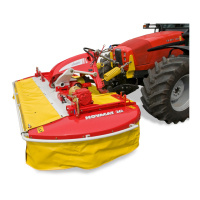Do you have a question about the Poettinger TOP 842 C and is the answer not in the manual?
Influences towing vehicle characteristics, danger of tipping on slopes.
Danger of injury when coupling/uncoupling. Ensure safety.
Adhere to load limits, power limits, and road rules.
Operator must know functions, check implement safety, be aware of dangers.
Check safety equipment, grease/oil, tyre pressure, wheel nuts, PTO, electrics.
Specifies required tractor power, hitching, and connections.
Importance of front axle ballast for steering and braking.
Requirements for tractor lifting unit and adjustment of struts.
Details hydraulic connections for rotor lift and working width.
Specifies electrical connections for lighting and electro-hydraulic control.
Check transportation locks and dealer inspection.
Procedures for coupling to tractor, support stand, electrical, hydraulics, and cardan shaft.
Adjusting driveshaft length for correct operation.
Instructions on how to safely park the machine.
Safety and operational advice for using the machine.
Step-by-step guide to deploy the machine.
Procedure for safely lowering the rotor arms.
Procedures for tine arm removal and refitting.
Steps to transition from headland to working mode.
Steps to transition from working to headland mode.
Requirements and steps for setting rotor chassis incline.
How to adjust outer tine height using eccentric or spindle systems.
Procedure for setting the rake height using a hand crank.
Steps to align height indicators on both rotor units.
Detailed steps for setting up a left rotor with tandem chassis.
Recommended and maximum cardan shaft speeds.
How to adjust the swath apron height.
How to operate with only one rotor.
Procedure for adjusting the working width.
Adjusting the curved track for better fodder collection.
How to adjust headland height for both rotor arms.
Steps to convert the machine for transport.
Procedure for raising rotor arms to transport position.
Steps to convert from headland to transport.
Safety and regulations for road transport.
How to operate the tine arm holder.
Specifies maximum transport dimensions.
Procedures for reducing transport height, including tine arm removal.
How to fold the hoop guard for the TOP 842 C.
How to fold the hoop guard for the TOP 962 C.
Importance and procedure for covering tines during transport.
How to fit tine coverings and check transport height.
How to store tine coverings when not in use.
Safety advice and danger of tipping.
General tips for maintaining the implement.
Recommendations regarding original and non-original spare parts.
Cautionary notes and checks for the hydraulic system.
Checks to perform before each use.
Oil quantity, level check, and oil change procedures.
Information on the steered chassis and setting the steering axle.
Adjusting tyre tracking for optimal performance.
Procedures for changing tine arms.
Tyre specifications and air pressure.
Lubrication and maintenance of the rotor unit.
Procedure for changing tine arm bearing bushes.
Filling and changing gear lubrication.
Visual guide to lubrication points and intervals.
Checking and tightening spring tine fixing screws.
Adjusting the working width mechanism.
Diagrams of the hydraulic system for both models.
Hydraulic plan specific to single rotor operation.
Lists required hydraulic and electrical connections.
Information about the machine's type plate.
Lists available optional equipment.
Lists available operational variations.
Defines the intended use of the swath rotor.
General safety recommendations and symbol explanation.
Importance of operating instructions for correct machine operation.
Only trained and authorized persons should operate the machine.
Use of original parts recommended; non-original parts not tested.
All protection devices must remain on the machine and be maintained.
Operator must know equipment functions and test safety before operation.
Observe manual, safety signs, legal requirements, and familiarize with controls.
Procedures and safety for attaching/detaching from 3-point hitch.
Safety when hitching, bearing load awareness, and coupling moveability.
Correct use of cardan shaft, protective parts, and safe operation procedures.
Information on driveshaft matching, working, and maintenance.
Conditions for mounting implements and determining ballasting.
Calculation methods for weight, loads, and ballasting.
| Rotor diameter | 3.70 m |
|---|---|
| Tine arms per rotor | 13 |
| Tines per arm | 4 |
| Number of Rotors | 2 |
| Max. Working Speed | 15 km/h |
| Working width | 7.7 to 8.4 m |
